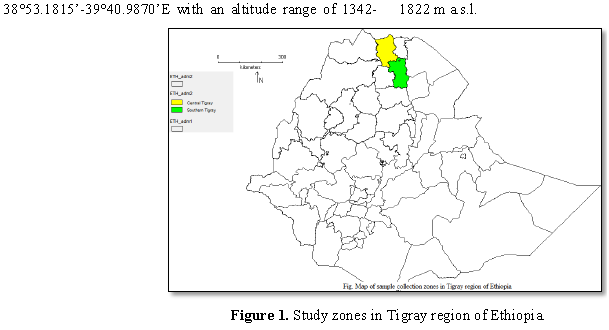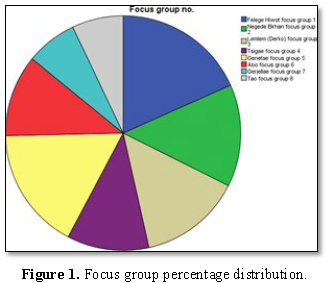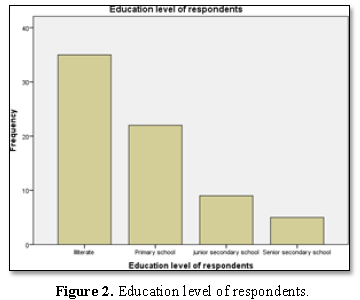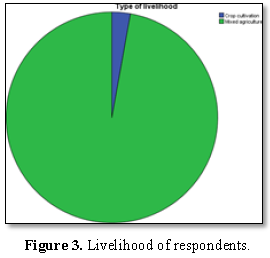958
Views & Citations10
Likes & Shares
Indigenous knowledge is, broadly speaking, the
knowledge used by local people to make a living in a particular environment.
This study aimed to study the traditional practice of cereal legume cropping
system and document the indigenous traditional community knowledge of soil
fertility improvement by farmers in Tigray region of Ethiopia. In addition, it
attempted to assess the existing knowledge of farmers about the role of
microbes in improving soil fertility during legume-cereal cropping.
A total of 71 farmer-informants were selected using
simple random sampling technique from the study area. A pre-tested and adjusted
semi-structured interview questionnaire was designed and administered to
explore farmers’ soil classification techniques, farmers’ indigenous and
inherent techniques of soil fertility assessment, cropping systems and their
knowhow about microbes associated with legume nodules and their effects in the
improvement of soil fertility and growth of crops. Descriptive frequency
statistics (Central tendency, dispersion and percentiles) was used to evaluate
all the variables using SPSS (2011) software ver.20.
The three most common farming practices carried out
by farmers in all study provinces (woredas)
are; strip cropping (82% of respondents), crop rotation (79% of respondents),
and mono-culture cropping (54% of respondents), respectively. The most common
types of crops they combine during crop rotation are sorghum, teff, barley,
maize and chick pea. Twenty eight percent of the respondents follow this
combination of cereal and legume crops in their crop rotation farming system.
This study also found out that most farmers living in the study area are aware
of the role of legumes in soil improvement but they were not able to reason out
how legume root nodules help the enhancement of soil fertility.
INTRODUCTION
Indigenous knowledge (IK) is, broadly
speaking, the knowledge used by local people to make a living in a particular
environment [1]. It can be defined as “A body of knowledge built up by a group
of people through generations of living in close contact with nature” [2]. The
term “Indigenous knowledge” sometimes refers to the knowledge possessed by the
original inhabitants of an area, while the term “local knowledge” is a broader
term which refers to the knowledge of any people who have lived in an area for
long period of time. As stated by Langill [3], such knowledge evolves in the
local environment so that it is specifically adapted to the requirements of
local people and conditions. It is also creative and experimental, constantly
incorporating outside influences and inside innovations to meet new conditions.
Langill [3] further advised that considering indigenous knowledge as “old
fashioned”, “backwards”, “static” or “unchanging” is a big mistake. Thus,
studying traditional indigenous knowledge of a community and documenting it is
not a simple task of gathering former knowledge but it is an act of searching
tremendous knowledge originated and developed for many generations in a
particular population through social experimentation and creation.
Farmers in different parts of the world
practiced different traditional cropping systems. Legume-cereal cropping is one
of the most frequently employed farming systems. Legumes are potential sources
of plant nutrients that complement/supplement inorganic fertilizers for cereal
crops
Crop rotation is a practice of
rotating/changing the type of crops grown in the field each season or each year
(or changing from crops to fallow). It is a key principle of conservation
agriculture because it improves the soil structure and fertility, and because
it helps control weeds, pests and diseases [5]. Farmers in ancient cultures as
diverse as those of China, Greece, and Rome shared a common understanding about
crop rotations. They learned from experience that growing the same crop year
after year on the same piece of land resulted in low yields and that they could
dramatically increase productivity on the land by cultivating a sequence of
crops over several seasons. They came to understand how crop rotations,
combined with such practices as cover crops and green manures, enhanced soil
organic matter, fertility and tilth [6].
Intercropping is also an ancient practice,
placed on the fringes of a ‘modern agriculture’ dominated by large areas of
monocultured, resource-consuming and high-yielding crops. Intercropping is
considered as a means to address some of the major problems associated with
modern farming, including moderate yield, pest and pathogen accumulation, soil
degradation and environmental deterioration, thereby helping to deliver
sustainable and productive agriculture [6]. It involves two or more crop
species or genotypes growing together and coexisting for a time. This latter
criterion distinguishes intercropping from mixed monocropping and rotation
cropping. Intercropping is common, particularly in countries with high amounts
of subsistence agriculture and low amounts of agricultural mechanization [5].
Developing countries such as Ethiopia, Niger,
Mali China, India, and Indonesia have shown considerable interest in
intercropping to enhance productivity [7]. In particular, cereal/legume
intercropping is commonly employed in China and sub-Saharan Africa and has
shown over-yielding and nutrient acquisition advantages under adverse
conditions. Furthermore, intercropping also provides an important pathway to
reduce soil erosion, fix atmospheric N2, lower the risk of crop
failure or disease and increase land use efficiency [7].
Intercropping is often undertaken by farmers
practicing low-input (high labor), low-yield farming on small parcels of land.
Under these circumstances, intercropping can support increased aggregate yields
per unit input, insure against crop failure and market fluctuations, meet food
preference and/or cultural demands, protect and improve soil quality, and
increase income. Intercrops can be divided into mixed intercropping
(simultaneously growing two or more crops with no, or a limited, distinct
arrangement), relay intercropping (planting a second crop before the first crop
is mature), and strip intercropping (growing two or more crops simultaneously
in strips, allowing crop interactions and independent cultivation) [5].
Various types of intercropping were known and
presumably employed in ancient Greece about 300 B.C. Theophrastus, among the
greatest early Greek philosophers and natural scientists, notes that wheat,
barley, millets and certain pulses could be planted at various times during the
growing season often integrated with vines and olives, indicating knowledge
of the use of intercropping [8].
Traditional agriculture, as practiced through the centuries all around the
world, has always included different forms of intercropping. In fact, many
crops have been grown in association with one another for hundred years and
crop mixtures probably represent some of the first farming systems practiced
[9]. Now a day, intercropping is commonly used in many temperate, tropical and
subtropical parts of the world particularly by small-scale traditional farmers
[10]. Traditional multiple cropping systems are estimated to still provide as
much as 16-22% of the world’s food supply [11].
In Ethiopia, plow agriculture in its current
form as a dominant tool appears in rock painting dating as far back as 500 AD.
This annual crops (grain, legume and oil seed) based plow agriculture was
centered in the central and northern highlands of Ethiopia. Tigray is located
in the Northern major highlands of Ethiopia. Even though it is difficult to
find complete and exact information when and where crop rotation, intercropping
and other traditional cropping systems were started in Ethiopia, it is
understood that the practice of cropping began many centuries ago. By fixing
atmospheric N2, legumes offer the most effective way of increasing
the productivity of poor soils either in monoculture, intercropping, crop
rotations or mixed cropping systems. These cropping systems are commonly used
in many temperate, tropical and subtropical parts of the world particularly by
small-scale traditional farmers. This study aimed to study the traditional
practice of cereal legume cropping system and document the indigenous
traditional community knowledge of farmers in Tigray region of Ethiopia. In
addition, it attempted to assess the existing knowledge of farmers about the
role of microbes in traditional cropping systems, especially in legume-cereal
cropping, in a systematic way.
MATERIALS AND
METHODS
Description of study
area
Data collection was undertaken in 8
administrative units (kebeles) of 3 woredas
in Tigray region of Ethiopia, which were considered to be representative of the
practice of cereal-legume cropping system in the highland areas of Ethiopia. A
semi-structured interview based survey was used to collect the data [12,13]. In
each kebeles, the research team randomly selected a representative group of
farmers with different ages and social classes. The team used interview guides
from the study woreda agricultural
office during individual and group discussions so that the team members easily
understand farmers’ perceptions of soil fertility, techniques of soil
classification, and their cropping systems. They also attempted to assess
farmers’ knowledge/knowhow of microbes associated with legumes and their
effects in soil fertility improvement [12,13].
Seventy one farmer-informants were selected
using simple random sampling technique from the study area. Semi-structured
interview questionnaire was designed and administered to explore farmers’ soil
classification techniques, farmers’ indigenous and inherent techniques of soil
fertility assessment, cropping systems and their knowhow about microbes
associated with legume nodules and their effects in the improvement of soil
fertility and growth of crops. The semi-structured interview questionnaire was
pre-tested and adjusted before its full administration [12]. The questionnaire
was administered by researchers working in Ethiopian Biodiversity Institute,
microbial biodiversity directorate; bacteria and fungus case team and
agricultural experts working at the study areas. Focus group discussion was
made with members composed of representatives of each kebele who were community
elders and young farmers who have been engaged in farming. 8-12 informants in
each focus group were included for the study [12].
Data analysis
Descriptive frequency statistics (Central
tendency, dispersion and percentiles) was used to evaluate all the variables
using SPSS (2011) software ver.20. ANOVA was done to compare the mean values of
the variables. P-value less than 0.5 were taken as significance.
RESULTS AND
DISCUSSION
Characteristics of respondents/informants
Farmer informants who were included in the
study were from different age group, education level and livelihood background.
The mean age of the informants was 48 and their mean family size was 6. Their
education level was also different. 49% of the respondents were illiterates but
51% of them completed either primary and/or secondary school (Figure 2). Ninety three percent of the
total informants lead their life by engaging in mixed agriculture and the rest
3% rely only on crop cultivation (Figure
3).
Farmers’ techniques of soil classification
This study indicates that farmers living in
the two zones of Tigray have various techniques of traditional practices
adopted for classification of soil. All of the respondents answered that they
basically use soil color, soil texture and gravel content of the soil as
criteria to classify soil. Different types of soil color are used by farmers in
all kebeles of the study areas. The
major soil color types used by farmers are black, brown, red and gray. In
addition, three major types of soil texture; rough, smooth and muddy are most
often used by all farmers in the study area. They adopt different methods to
assess the soil texture. Observation by eye, hand touch and ploughing are the
most important methods frequently adopted by farmers to differentiate the soil
roughness or smoothness.
Farmers’ techniques
of soil fertility assessment
Farmers in the study area do have tremendous
indigenous and inherent techniques of soil fertility assessment. Even though
they traditionally adopt various techniques of soil assessment, they most
frequently use soil color and texture change, productivity decline, appearance
of sand in the field, poor seedling germination immediately after sawing,
yellowing and other coloration of crop leaves during crop growth,
dicotyledonous weeds occurrence and soil fauna (earth worm casting activity),
soil workability, slope and the soil’s depth criteria. Sixty eight percent of
the respondents explained that they use these criteria in combination in their
day to day activity of farming. Fourteen percent of the respondents use this
criterion in combination except soil fauna (Earth worm casting activity),
appearance of sand in the field and poor seedling germination immediately after
sawing to assess the soil fertility.
Forty two percent of the respondents
explained that they consider the soil is fertile if the soil has black color,
smooth texture and has high water holding capacity. But, fourteen percent of
the respondents said that they take the soil fertile if it is also red in color
but smooth in texture. In general terms, farmers give soil rank as fertile if it
has black color, red color, gray color and brown color, respectively.
Farmer respondents explained that they use
dicotyledonous weeds occurrence as a means to tell whether the soil is either
fertile or infertile. It is found that 15 types of dicotyledonous weeds are
used by farmers as indicators of fertile soil. They also mentioned another 9
types of dicotyledonous weeds that are used by them as indicators of infertile
soil. The most commonly used fertile soil indicator weed is gemale (39.44% of
respondents) which is followed by weed mestenagir (36.62% of respondents) and
hitsihitsi (28.13% of respondents). On the other hand, akenichira (100% of
respondents) is the most frequently employed infertile soil indicator weed
followed by kinche (53.5% of respondents) and eshoh mergem (28.2% of
respondents).
Farmers’ methods of
cropping systems and their knowledge about the role of microbes associated with
legume root nodule
This study showed that farmers in Tigray
district practice different types of cropping systems. They perform one or the
other cropping system at different time; Mono-cropping, crop rotation,
intercropping, sequential cropping, and strip cropping. The three most common
farming practices carried out by farmers in all study woredas are; strip cropping (82% of respondents), crop rotation
(79% of respondents) and mono-culture cropping (54% of respondents),
respectively.
The main reason farmers responded why they
rotate crops from seasons to seasons is to increase yield, improve soil
fertility and control weeds, pests and diseases. Around 82% of the respondents
practiced crop rotation in every other year. The rest respondents practiced
crop rotation in less than year time. The most common types of crops they
combine during crop rotation are sorghum, teff, barley, maize and chick pea.
Twenty eight percent of the respondents follow this combination of cereal and
legume crops in their crop rotation farming system. A sorghum, teff and sesame
seed is the next common combination of crops followed by farmers during crop
rotation time.
Farmers consider different factors in
selecting the right crops to combine them for crop rotation system. The major
criteria they follow are ability of the combined crops in complementing one
another (44%), ability of the crop in improving the soil fertility (42%) and
ability of the crops in covering the soil (39%), respectively. Only 17% of the
respondents included in the study accounted the type of roots the crops have is
used in selecting the right crops to combine in crop rotation practices. Forty
four percent of farmers living in the study district also have frequent
practice of using fallow land for crop rotation rather than combining crops.
They take five years on average of duration of fallow land period between two
consecutive crop rotations.
All of the farmer respondents are aware of
the difference between the root types of cereal and legume crops. Eighty six
percent of the farmers do not have the knowhow about the association among the
roots, root nodules and N2 fixation carried out by microbes
associated with legume roots. But, in the contrary to this fact 89% of the
respondents are found to have the knowledge about the importance or the role of
legume crops during crop rotation in the improvement/enhancement of soil fertility.
This indicates that most farmers living in the study area are aware of the role
of legumes in soil improvement but they do not have the scientific background
about the role of microbes associated with legume root nodules in the
enhancement of soil fertility [14,15].
CONCLUSION
The three most common farming practices
carried out by farmers in all study provinces (woredas) are; strip cropping (82% of respondents), crop rotation
(79% of respondents), and mono-culture cropping (54% of respondents), respectively.
The most common types of crops they combine during crop rotation are sorghum,
teff, barley, maize and chick pea. Forty five percent of farmer respondents
living in the study district also have the practice of using fallow land for
crop rotation rather than combining crops. They take five years on average of
duration of fallow land period between two consecutive crop rotations.
This study further more indicated that
farmers in the study area do have tremendous indigenous and inherent techniques
of soil fertility assessment. Even though most of them are aware of the role of
legumes in soil improvement, they do not have the scientific background about
the role of microbes associated with legume root nodules in the enhancement of
soil fertility as indicated in other study done by the same authors of this
study in North Shoa of Ethiopia.
1. Warren DM (1991) Using indigenous
knowledge for Agricultural development. World Bank Discussion Paper 127.
Washington D.C.
2. Johnson M (1992) Lore: Capturing traditional
environmental knowledge. IDRC: Ottawa, Canada.
3. Langill S (1999) Indigenous
knowledge: A resource kit for sustainable development researchers in dry land
Africa. People, land and water initiative. IDRC: Ottawa, Canada.
4. Massawe PI, Mtei KM, Munishi LK,
Ndakidemi PA (2016) Improving Soil fertility and crops yield through
maize-legumes (Common bean and Dolichos lablab) intercropping systems. J Agric
Sci 8.
5. Brooker RW, Bennett AE, Cong WF,
Daniell TJ, George TS, et al. (2015) Improving intercropping: A synthesis of
research in agronomy, plant physiology and ecology. New Phytol 206: 107-117.
6. Baldwin KR (2006) Organic
production-Crop rotations on organic farms. Centre for environmental farming
system. Available at: http://www.oacc.info/Docs/Cefs/Crop_Rotations.pdf
7. Wang ZG, Jin X, Bao XG, Li XF,
Zhao JH, et al. (2014) Intercropping enhances productivity and maintains the
most soil fertility properties relative to sole cropping. PLoS One 9: e113984.
8. Papanastasis VP, Arianoutsou M,
Lyrintzis G (2004) Management of biotic resources in ancient Greece. In:
Proceedings of 10th Mediterranean Ecosystems (MEDECOS) Conference,
Rhodes, Greece 25: 1-11.
9. Plucknett DL, Smith NJH (1986)
Historical perspectives on multiple cropping. In Multiple Cropping Systems,
Francis CA, Ed. New York, USA: MacMillan Publishing Company.
10. Altieri MA (1991) Traditional
farming in Latin America. Ecol 21: 93-96.
11. Altieri MA (1999) The ecological
role of biodiversity in agroecosystems. Agric Ecosyst Environ 74: 19-31.
12. Grenier L (1998) Working with
indigenous knowledge: A guide for researchers. International Development
Research Centre, Ottawa, ON, Canada K1G 3H9.
13. Pretty J, Guijt I, Thompson J, Scoones
I (1995) A trainer’s guide for participatory approaches. IIED. London.
14. Encyclopedia Britannica (2017)
Shewa Encyclopedia Britannica Inc. Available at: https://www.britannica.com/place/Shewa
15. McCann JC (2017) Oxford Research
Encyclopedia of African History: The History of Agriculture in Ethiopia.
QUICK LINKS
- SUBMIT MANUSCRIPT
- RECOMMEND THE JOURNAL
-
SUBSCRIBE FOR ALERTS
RELATED JOURNALS
- Journal of Biochemistry and Molecular Medicine (ISSN:2641-6948)
- Journal of Veterinary and Marine Sciences (ISSN: 2689-7830)
- Food and Nutrition-Current Research (ISSN:2638-1095)
- Journal of Genomic Medicine and Pharmacogenomics (ISSN:2474-4670)
- Advances in Nanomedicine and Nanotechnology Research (ISSN: 2688-5476)
- Journal of Astronomy and Space Research
- Journal of Microbiology and Microbial Infections (ISSN: 2689-7660)





